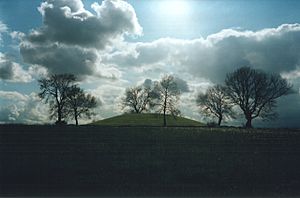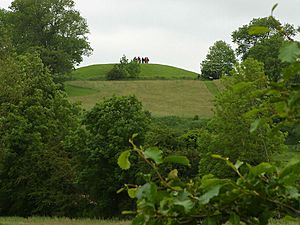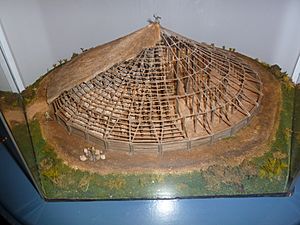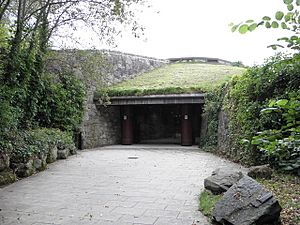Navan Fort facts for kids

Navan Fort or Eamhain Mhacha
|
|
| Location | County Armagh, Northern Ireland |
|---|---|
| Coordinates | 54°20′53″N 6°41′50″W / 54.34806°N 6.69722°W |
Navan Fort (called Eamhain Mhacha in old Irish) is a very old and important place near Armagh, Northern Ireland. People in ancient times believed it was one of the greatest royal places in pre-Christian Gaelic Ireland. They thought it was the capital city of the Ulaidh people.
Navan Fort is a large circular area on a hilltop. It has a big bank and ditch around it. Inside, there's a circular mound and what's left of an old burial site called a ring barrow. Scientists who have studied the site found that there were buildings here a long time ago. One was a huge round building, like a roundhouse, which some think was a temple.
In a special ceremony, this wooden building was filled with stones. Then, it was deliberately burned down. After that, it was covered with earth to create the mound you see today. Many believe Navan Fort was a pagan ceremonial site. It was seen as a very sacred place. It also plays a big part in Irish mythology, especially in stories from the Ulster Cycle.
Navan Fort is the main part of a bigger area called the 'Navan complex'. This area also includes other ancient sites. These are Haughey's Fort (an older hilltop enclosure), the King's Stables (a man-made ritual pool), and Loughnashade (a natural lake where special offerings were found). The name Eamhain Mhacha might mean "Macha's twins" or "Macha's brooch". Macha was a local goddess. The name 'Navan' comes from the Irish name An Eamhain.
Contents
The old Irish name for Navan Fort is Eamhain Mhacha. The second part of the name, Macha, refers to a goddess. The city of Armagh (Ard Mhacha) is also named after her.
However, the full meaning of Eamhain Mhacha isn't completely clear. Some think it means "Macha's twins" or "Macha's pair". This could refer to the two main features on the hilltop, or to Navan Fort and another nearby monument. Others believe it means "Macha's brooch", perhaps because of the site's shape. There are old stories that try to explain how the name came about.
Around 200 AD, a Greek mapmaker named Ptolemy wrote about a place called Isamnion in southeastern Ulster. Some experts think this was Emain. They believe it comes from an old Celtic word meaning "holy mound". The name Eamhain Mhacha, and its shorter form An Eamhain, later became 'Owenmagh', 'Nawan', and finally 'Navan' in English.
Navan Fort is also sometimes called Navan Rath. It is a protected historical site in the area known as Navan. You can find it on a low hill about 1.6 kilometers (1 mile) west of Armagh.
The site is a circular area about 250 meters (820 feet) across. It is surrounded by a large bank and a ditch. The ditch is on the inside, which means it was likely built for symbolic reasons, not for defense.
Inside this large circle, you can see two main features. To the northwest, there's an earthen mound. It is about 40 meters (130 feet) wide and 6 meters (20 feet) high. To the southeast, you can see the circular outline of a ring-barrow. This is about 30 meters (98 feet) wide.
Archaeologists have found flint tools and pieces of pottery at the site. These show that people were active here as far back as the Neolithic period (around 4000 to 2500 BC).
Bronze Age Structures
Around 800 BC, during the Bronze Age, people built a ring of wooden poles. This was at the western part of the site, where the large mound now stands. This wooden circle was 35 meters (115 feet) wide. It was surrounded by a circular ditch with an entrance on the east side. This ditch was 45 meters (148 feet) wide, 5 meters (16 feet) across, and 1 meter (3 feet) deep.
Iron Age Buildings
In the 4th century BC, during the Iron Age, a new wooden structure was built in the same spot. It was a round building connected to a larger round enclosure, forming a figure-of-eight shape. Both parts had entrances on the east. The larger ring was 30 meters (98 feet) wide, and the smaller one was about 20 meters (66 feet) wide. The smaller building had a hearth (a fireplace).
Experts think this structure was a roundhouse with an attached yard or a special area for rituals. Finds from this time suggest that important people lived here, like a king, a leader, or a druid (a Celtic priest). Items found include a finely decorated pin and the skull of a Barbary monkey. This monkey was likely a pet that was brought from far away. This structure was rebuilt several times over the next few centuries.
The Great Roundhouse and Mound
Around the 1st century BC, a huge wooden roundhouse-like building was constructed in the same spot. It was 40 meters (130 feet) wide. It had an outer wall and four inner rings of posts, which probably held up a roof. In the very center was a huge oak pillar. Scientists used dendrochronology (tree-ring dating) to find out this pillar was cut in 95 BC. It might have stood about 13 meters (43 feet) tall. This building had an entrance on the west, towards the setting sun. This suggests it was not a normal home. A ditch and bank were dug around it. There is also evidence that the huge ditch and bank around the entire hill were dug around the same time.
Not long after it was built, this huge building was filled with thousands of stones. The stones reached a height of almost 3 meters (10 feet). This stone pile, called a cairn, was flat on top and divided into wedge shapes. From above, it looked like a spoked wheel. Some evidence suggests these stones came from an older monument nearby, perhaps a passage tomb.
Then, the building was deliberately burned down. After that, it was covered with a mound of earth. This earth came from many different types of soil, suggesting it was brought from areas all around. Similar building and burning rituals have been found at other ancient sites like Tara and Dún Ailinne.
Eastern Site Structures
In the 1st or 2nd century BC, a figure-of-eight structure was also built at the eastern part of the site. It was similar to the ones at the western site and might have been built around the same time as the mound. The larger ring was 30 meters (98 feet) wide, and the smaller one was about 20 meters (66 feet) wide.
This figure-of-eight structure was later removed and replaced by another round wooden building. This one had double walls, a central fireplace, and an eastern entrance. Two graves were found just outside this entrance. This structure was then replaced by a ring-barrow. A ring-barrow is a round mound, usually built over a burial, surrounded by a ditch and bank.
Why Was it Built?
People believe that creating the mound was a special ritual act. However, its exact meaning is not clear, and there are several ideas. The wooden building might have been built just to be burned, or it might have been used briefly as a temple before its planned destruction.
Experts suggest that the event was a sacrifice to the gods. The structure was symbolically given to the Otherworld (a spiritual realm) by being ritually burned and buried. Some compare it to the 'wicker man' ritual, which was said to be performed by the Gauls, where a large wooden figure was burned with a living sacrifice inside. The huge outer bank and ditch were probably made to mark the hilltop as a sacred place. It might also have been seen as a way to keep the power of the Otherworld within that special area.
One idea is that the mound was made to be a connection between this world and the Otherworld. It might have been an attempt to copy an ancient burial mound (called a sídhe). These mounds were believed to be gateways to the Otherworld and the homes of ancient gods. This theory suggests the mound was a platform where druids would perform ceremonies and where kings would be crowned. This would allow them to gain power and authority from the gods and ancestors.
It's possible that each part of the monument represents something. The stones inside the wooden structure might represent souls in the house of the dead, or the souls of brave warriors. Another idea is that the monument shows the joining of the three main groups in society: druids (the wooden frame), warriors (the stones), and farmers (the soil). The central pillar could also represent the world pillar or world tree. This links the sky, the earth, and the underworld. The pattern of the stone cairn might look like a sun wheel, a symbol linked to Celtic sun or sky gods.
One expert, Dr. Chris Lynn, suggests that in the early 1st century BC, Navan was seen as an "otherworld place". It was believed to be the home of gods and goddesses. It was a Celtic tribe's sanctuary, their capital, and a sacred symbol of their power and unity.
Recent studies using modern technology like lidar (light detection and ranging) and magnetic gradiometry have mapped the site underground. They found evidence of Iron Age and medieval buildings. This suggests that Navan Fort was "an incredibly important religious center and a place of paramount sacral and cultural authority in later prehistory."
In the Ulster Cycle of Irish mythology, Emain Macha is the royal capital of the Ulaidh people. They are the group who gave their name to the province of Ulster. The stories say it was the home of Conchobar mac Nessa, the king of Ulster. He was also said to have a training school for warriors at Emain.
King Conchobar's great hall at Emain was called in Chraebruad (meaning "the red-branched" or "red-poled building") by writers in the Middle Ages. His royal warriors are known as the Red Branch Knights in English stories.
Emain Macha is said to be named after Macha, who was likely a goddess of power and leadership for the Ulaidh. One story says that Macha, who was a queen of the Ulaidh, made her enemy's sons dig the large bank and ditch. She marked out the area with her neck-brooch (eomuin), which is how the name came about.
In another tale, Macha is the magical wife of Crunnchu. Crunnchu promised not to speak about her special powers. But he boasted that his wife could outrun the king's horses. The king then forced the pregnant Macha to race the horses. She won, but then gave birth to twins right at the finish line. Before she died, she cursed the Ulstermen. She said they would be overcome with the weakness of childbirth when they needed their strength the most. This story explains why the Ulstermen were weak during the Táin Bó Cúailnge (Cattle Raid of Cooley). This tale explains the name Emain Macha as "Macha's twins".
The Annals of the Four Masters (an old Irish history book) says that a group called the Three Collas took over the area in 331 AD. They burned Emain Macha and pushed the Ulaidh people east across the River Bann. Another tradition says that Emain Macha was destroyed by Niall of the Nine Hostages, or his sons, in the century after that.
Many other characters from Irish mythology are linked to Emain Macha, including:
- Amergin the poet
- Cú Chulainn, the famous warrior
- Emer, his strong and beautiful wife
- Conall Cernach, his foster-brother and close friend
- Lóegaire, another warrior
- Cathbad, the chief druid
- Fergus mac Róich, another great warrior and king
- Deirdre of the Sorrows, and Naoise, her brave lover
- Leabharcham, the wise woman
For many years, until 1985, the site was in danger from a nearby limestone quarry that was growing. Thanks to a group of activists called Friends of Navan, a public meeting was held that year. This meeting stopped further quarrying. It also suggested that Navan should be developed for visitors.
A visitor center was opened in 1993. It had old objects and audio-visual displays. But it closed in 2001 because it ran out of money. It reopened in 2005 after the site was bought by Armagh City and District Council.
Other important ancient sites are nearby. These include Haughey's Fort, an older Bronze Age hill fort about 1 kilometer (two-thirds of a mile) to the west. There's also the King's Stables, a man-made pool from the Bronze Age. And Loughnashade, a natural lake where Iron Age artifacts have been found.
See also
 In Spanish: Emain Macha para niños
In Spanish: Emain Macha para niños
- An sluagh sidhe so i nEamhuin? ("Is this a fairy host in Eamhain Mhacha?") – an Irish poem from the late 16th century.
Texts
- Bricriu's Feast
- Oxford Dictionary of Celtic Mythology






